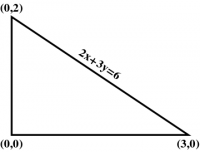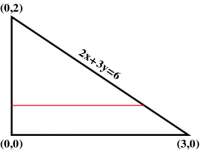Order of Integration
What if the limits of integration are not constant?
Let's start with a simple example, and find the area of the triangle between the graph of the line $2x+3y=6$ and the axes, as shown in Figure 1.
First of all, the area of a triangle is half of its base times its height, so we know that the area must be $(2)(3)/2=3$ square units. Let's check this via integration.
Don't forget: Chop and add. So the first thing to do is to figure out how to chop. Let's start with single integrals, that is, let's chop in just one direction. Let's try chopping vertically, as shown in Figure 2. So we're going to chop the area into thin vertical strips, of width $dx$. What is the height of each such strip? Solve the equation of the line for $y$, obtaining \begin{equation} y = 2 - \frac23x \end{equation} Thus, each strip goes from $y=0$ to $y=2-2x/3$, at constant $x$, and the area of each strip is therefore $(2-2x/3)\,dx$. Now add this up for all strips to obtain \begin{equation} A = \int_0^3 \left(2-\frac23\,x\right)\,dx = \left( 2x - \frac{x^2}{3} \right)_0^3 = 3 \end{equation} as expected.
But what if the original integral hadn't been so easy? Suppose we wanted to find the total amount of chocolate on the triangle, with the density given by \begin{equation} \sigma = a(x^2+y^2) \end{equation} where $a$ is some constant with dimensions of $\hbox{mass}/\hbox{length}^4$. Since $\sigma$ depends on both $x$ and $y$, we must chop in both directions. But we can still use Figure 2 to guide us.
Chop the triangle into little rectangular regions of area $dA=dx\,dy$. The amount of chocolate on each rectangle is $\sigma\,dA$. So the total amount $M$ of chocolate is given by \begin{equation} M = \int_T \sigma\,dA \end{equation} where $T$ denotes the triangle. We first add these up vertically, along the line shown in Figure 2. That is, we integrate first with respect to $y$. What are the limits? We already know the answer: the line starts at $y=0$, and goes to $y=2-2x/3$! So those are the limits for the integration with respect to $y$. We then add up the “columns” in the $x$-direction; $x$ clearly goes from $0$ to $3$. Thus, \begin{equation} M = \int_0^3 \int_0^{2-2x/3} \sigma\,dy\,dx = … = \frac{39}{2} a \end{equation}
Note that in the special case where $\sigma=1$ we would have recovered our original integral for the area; writing down the length of the line was equivalent to doing the inner integral.
But what if we had integrated in the other direction first, as shown in Figure 3? The argument in that case is exactly the same. The line now goes from $x=0$ to $x=3-3y/2$, and we must then add up the “rows” in the $y$-direction, with $y$ going from $0$ to $2$. Thus, we obtain \begin{equation} M = \int_0^2 \int_0^{3-3y/2} \sigma\,dx\,dy = … = \frac{39}{2} a \end{equation} and (of course) we get the same answer.
This is a good opportunity to ensure that you know the difference between what you are integrating ($\sigma\,dx\,dy$), and where you are integrating ($T$). The limits of integration depend only on $T$, and have nothing whatever to do with $\sigma$. So you should be able to write down the limits of integration looking only at how to chop up a given region. Conversely, given only the limits of integration, you should be able to figure what what the region is. Practice these two skills! Some integrals are easier when done one way than the other, so it's important to be able to go back and forth.


